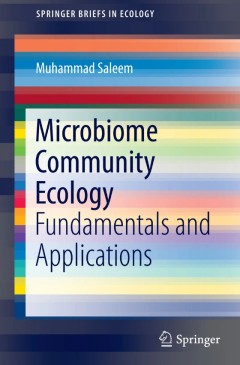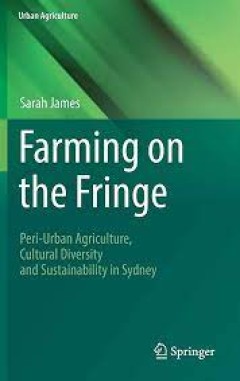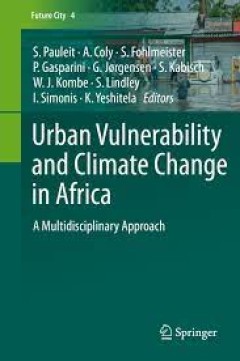Filter by

Microbial Degradation of Synthetic Dyes in Wastewaters
Today synthetic dyes are used extensively in the textile dyeing, paper printing, color photography, pharmaceuticals, food and drink, cosmetic and leather industries. As of now, over 100,000 different dyes are available, with an annual production of over 700,000 metric tons. These industries discharge an enormous amount of colored effluents into natural water bodies, with or without treatment. T…
- Edition
- 1
- ISBN/ISSN
- 978-3-319-10941-1
- Collation
- XIV, 367
- Series Title
- Environmental Science and Engineering
- Call Number
- -

Microbiome Community Ecology
This book reviews the mechanisms, patterns, and processes that regulate prokaryotic diversity through different habitats in the context of evolutionary and ecological hypotheses, principles, and theories. Despite the tremendous role of prokaryotic diversity in the function of the global ecosystem, it remains understudied in comparison to the rest of biological diversity. In this book, the autho…
- Edition
- 1
- ISBN/ISSN
- 978-3-319-11664-8
- Collation
- VIII, 152
- Series Title
- SpringerBriefs in Ecology
- Call Number
- -

Farming on the Fringe Peri-Urban Agriculture, Cultural Diversity and Sustain…
This volume offers a new perspective to debates on local food and urban sustainability presenting the long silenced voices of the small-scale farmers from the productive green fringe of Sydney’s sprawling urban jungle. Providing fresh food for the city and local employment, these culturally and linguistically diverse farmers contribute not only to Sydney’s globalizing demographic and cultur…
- Edition
- -
- ISBN/ISSN
- 978-3-319-32235-3
- Collation
- XI, 197
- Series Title
- -
- Call Number
- -

Family Farming and the Worlds to Come
What is family farming? How can it help meet the challenges confronting the world? How can it contribute to a sustainable and more equitable development? Not only is family farming the predominant form of agriculture around the world, especially so in developing countries, it is also the agriculture of the future. By declaring 2014 the “International Year of Family Farming,” the United Nati…
- Edition
- -
- ISBN/ISSN
- 978-94-017-9358-2
- Collation
- X, 361
- Series Title
- -
- Call Number
- -

Micro-Behavioral Economics of Global Warming
This book presents a foundation for studying the micro-behavioral economics of global warming. The author develops an empirical model, named the Geographically-scaled Micro econometric model of Adapting Portfolios (G-MAP) in response to climatic changes and risks. The G-MAP model is applied to observed decisions of agricultural and natural resource enterprises in Sub-Saharan Africa and South Am…
- Edition
- 1
- ISBN/ISSN
- 978-3-319-15945-4
- Collation
- IX, 102
- Series Title
- Advances in Global Change Research
- Call Number
- -

Water Cycle Management A New Paradigm of Wastewater Reuse and Safety Control
This book focuses on environmental engineering, and on wastewater treatment and reuse in particular, which is a vital aspect for countries and regions suffering from water shortages. It introduces a new water cycle management concept for designing water systems that mimic the hydrological cycle, where reclaimed water is produced, stored/regulated, supplied and used in a semi-natural manner so t…
- Edition
- -
- ISBN/ISSN
- 978-3-662-45821-1
- Collation
- VIII, 98
- Series Title
- -
- Call Number
- -

Use of Economic Instruments in Water Policy Insights from International Expe…
This book assesses both the effectiveness and efficiency of implemented Economic Policy Instruments (EPIs) in order to achieve water policy goals and identifies the preconditions under which they outperform alternative (e.g. regulatory) policy instruments and/or can complement them as part of complex policy mixes. The development of a consolidated assessment framework helps clarify (and where p…
- Edition
- -
- ISBN/ISSN
- 978-3-319-18287-2
- Collation
- 4 b/w illustrations, 42 illustrations in colour
- Series Title
- -
- Call Number
- -

Urban Vulnerability and Climate Change in Africa A Multidisciplinary Approach
Urbanisation and climate change are among the major challenges for sustainable development in Africa. The overall aim of this book is to present innovative approaches to vulnerability analysis and for enhancing the resilience of African cities against climate change-induced risks. Locally adapted IPCC climate change scenarios, which also consider possible changes in urban population, have been …
- Edition
- -
- ISBN/ISSN
- 978-3-319-03982-4
- Collation
- 16 b/w illustrations, 115 illustrations in colour
- Series Title
- -
- Call Number
- -

Molecular Magnetism of Lanthanides Complexes and Networks
Over the last ten years a fresh air has been blowing in the field of molecular magnetism with the re-introduction of lanthanides ions as spin carriers in magnetic molecules. The strong magnetic moment and huge magnetic anisotropy of lanthanide ions has enabled significant breakthroughs in magnetic blocking temperature and related phenomena. The chemical versatility of these ions is also a stron…
- Edition
- -
- ISBN/ISSN
- -
- Collation
- -
- Series Title
- -
- Call Number
- 628 MOL

Noise and Vibration Control in the Built Environment
With global urbanization rapidly rising and the increasing need of high-quality built environments, the requirement of achieving improved sound quality, both for outdoor and indoor environments, has received a lot of attention. This Special Issue collection reflects the current state of the art, with 12 papers covering environmental acoustics; the influence of soundscapes on people’s behavior…
- Edition
- -
- ISBN/ISSN
- 978-3-03842-421-5
- Collation
- -
- Series Title
- -
- Call Number
- 628 NOI
 Computer Science, Information & General Works
Computer Science, Information & General Works  Philosophy & Psychology
Philosophy & Psychology  Religion
Religion  Social Sciences
Social Sciences  Language
Language  Pure Science
Pure Science  Applied Sciences
Applied Sciences  Art & Recreation
Art & Recreation  Literature
Literature  History & Geography
History & Geography